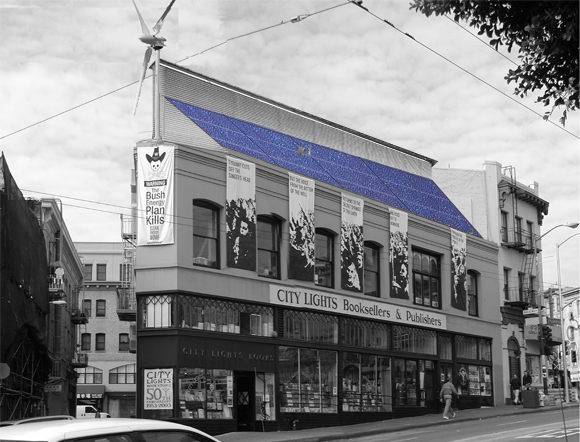
San Francisco’s billion-dollar investment in a solar energy infrastructure over the next three years will fundamentally change its built urban environment. Architects could take a leading role in this process, both in designing the new infrastructure as a ubiquitous presence in the City, and also in re-conceptualizing individual building designs around local conditions and needs, harnessing location-specific energy resources such as sunlight and wind, and combining them to serve uses such as hospitals, fire stations, server farms, or machine shops.
For over thirty years, visionary physicists and economists have posited a solar hydrogen future for America and the world. Following the change from burning trees to mining coal, and from coal to oil and gas combustion in the twentieth century, they have posited a third transformation that will liberate our way of life from climate crisis, fossil fuel wars, and nuclear proliferation.
Ironically, since the 1970s and early ’80s, the entire world has busily copied California’s brief but dramatic wind power leadership under Gov. Jerry Brown; but California’s vision of solarizing the power grid has never occurred on the scale imagined by the leaders of Appropriate Technology and the New Alchemy. Until recently, the only monuments to California’s worldwide leadership in alternative energy were a few wind turbine farms and experimental desert solar collectors. The lack of progress was caused not by price competition or technological innovation, but by politics and money. It was not until California and other states passed laws authorizing municipalities to purchase power and develop green-energy resources during California’s 2001 Energy Crisis that public works projects were prepared to deliver the solar hydrogen option today.
In California alone, over forty cities, including some of the largest, are now completing plans to develop solar technologies on a scale heretofore only imagined. In particular, the City of San Francisco is poised to use its community’s aggregate purchasing power to build the world’s largest solar photovoltaic power network, installing not just one large installation but an integrated network linking hundreds of large solar facilities, which, together with wind turbines, fuel cells, power storage systems, and other conservation and efficiency technologies, will power over 300,000 apartments. By 2009, the City will have rolled out a bomb-proof, blackout-proof energy infrastructure, transforming the urban environment in much the same way that the first municipal water and sewer systems transformed the modern city.
In keeping with its high-tech leadership role, the City of San Francisco will provide a first platform for the long-awaited solar hydrogen economy: not just talk about it, but build it, starting next year. Over the next decade, solar and other green power technologies will become as much a fixture of the San Francisco environment as the Golden Gate Bridge; blue glass, until now a curiosity, will appear like some new, surrealistic fish cartoon on every horizon.
Solar is a classic, municipal-type infrastructure. It was not the private market, but municipal revenue bonds, which delivered the nation’s water and sewer systems, its toll bridges, tunnels, power dams. Municipal revenue bonds make possible large-scale projects that take decades to pay back capital investments. In San Francisco, the money is coming from two sources, both developed by Oakland-based Local Power: a state law allowing “Community Choice” of power, passed in 2002, and an “H Bond” authority passed by San Francisco voters in 2001—a revenue bond authority not unlike the bonding authorities used to finance and build the major bridges and tunnels of virtually every city in the world.
The solar hydrogen economy is in this sense not historically unique, but falls under the rubric of municipal public-works projects. In the past, sewers were built to stop cholera and other diseases, bridges to ease urban congestion, and power dams to grow industrial manufacturing power. Today, a melting North Pole, nuclear proliferation, and energy wars are the crisis, and re-engineering of the power grid the lowest hanging fruit among available solutions.
Power production is ground zero of the energy crisis, because of both its size and its unique susceptibility to public policy. Electricity production is the largest single cause of greenhouse gas emissions causing climate change. Power plants produce two-thirds of the gases behind the nation’s urban child asthma epidemic and two-thirds of all nuclear materials. Among the other major causes, automobiles and the manufacturing industry are slower to change because of weak government powers—not so with the electricity industry.
San Francisco’s leadership among coastal U.S. cities is a forthright solution to the many energy crises of our time. Now ground zero in the “Community Choice” movement, its political leaders are preparing a plan and a competitive bidding process for the largest green-power, public-works project in world history: a “Hoover Dam of solar.” Rivaling the now booming German and Japanese solar industries in scale and financial commitment, the new infrastructure will remove 360 megawatts of electrical load from an entire urban community that now consumes 650-850 megawatts on any given day—over a third of San Francisco’s aggregate electricity footprint will be physically replaced in just three years with ubiquitous solar and other green power technologies. Under the plan, over half of all power sold in San Francisco will be locally green powered within twelve years.

Just as “all politics is local,” so ultimately are its problems and solutions; what the Congress and President could not achieve for the Kyoto Treaty, San Francisco’s mayor and city council just might. Combining renewable and fuel-free generation systems with power storage, heat recovery, cogeneration, and hybrid applications, San Francisco’s 360 MW Local Power network will fundamentally change the way San Franciscans get their power—permanently. Phase I will encompass 31 megawatts of solar photovoltaic cells installed throughout the City over three years—three times larger than the world’s largest existing network. This is the equivalent of 200 to 300 SAFEWAY-scale rooftops distributed on both city-owned and privately-owned buildings. The solar facilities alone will provide enough power for 31,000 city apartments in the afternoon.
Most architects agree that less research has been done on incorporating photovoltaics into existing buildings and that it is a more expensive and difficult process than incorporating photovoltaics into new construction. Yet the vast majority of any solar power built on the scale of San Francisco’s Local Power network will come from solar panels placed on existing buildings. Therefore, much of the research needed to implement the solar component of this legislation will have to focus on the reengineering of built urban environments. Kiss and Cathcart Architects and others have begun this process of devising economical and aesthetic structures to incorporate photovoltaics into exist ing buildings. Michael Jantzen’s designs incorporate wind-powered generators into elegant, open structures that also provide shade and some shelter. Many groups, including the International Energy Association with its TASK program and European Cooperation in the Field of Scientific and Technical Research (COST) have conducted extensive research on this subject.
Unlike typical twentieth-century public works infrastructure, which imposed grid patterns and earthmovers in a dominance of nature, this new infrastructure will obey nature. Solar panels must be placed to maximize both sun exposure and to match energy use among residents and businesses physically close to the facility. Thus, the selection of locations will depend on algorithms as complex as sites chosen for antennas in PCS, WiFi, or 3G wireless phone networks. San Francisco’s Local Power network reverses the old pattern of distant hidden megaliths connected by transcendent power lines, replacing it with visible, new, local energy systems that will inevitably revive the traditional architectural criterion of location. As the traditional watermill targeted high-flow waterfalls, San Francisco’s Local Power network will physically match sun, wind, tide, and wave to shop, kitchen, and venue—adapted to local conditions and maximizing the integration of related infrastructural resources and human needs.
In addition to the 200 to 300 warehouse-scale solar photovoltaic facilities in San Francisco neighborhoods, San Francisco’s Local Power network will include 72 megawatts of other green distributed generation, potentially including hydrogen fuel cells or hydrogen combustion turbines. Alternately, the introduction of wind turbines designed for dense urban areas, if carefully placed to minimize bird kills, noise, and visual impacts, could provide this component of the City’s plan. Hydrogen electrolysis facilities will have to be physically located near major solar facilities that power them. Again, the urban environment will witness a new kind of gas station—hydrogen storage tanks and power generators that emit no smoke whatsoever—only steam. Indeed, the City of Anchor Steam will find a new metaphor for its famous fog to hover above the splashes of blue glass.
When the Hoover Dam was bid out to California construction companies in the early twentieth century, nothing of its scale had ever before been attempted. Having designed and built it without precedent, Bechtel was transformed from a typical construction company into the giant it is today. The energy crisis is a major opportunity for the designers and builders of the urban environment. In San Francisco, this opportunity is now upon us. Renewable energy sources will soon be the only game in town. Architects would be wise to adapt their design principles to this fact and to lead in giving shape to San Francisco’s new power system as it transforms the urban sphere.
Co-author Paul Fenn is author of San Francisco’s “solar” H Bond Authority (2001), the State of California’s Community Choice law (2002), and San Francisco’s Energy Independence Ordinance (2004), for which he is now completing the City’s Implementation Plan and Competitive Bidding and Financing model as Executive Director for Local Power (local.org). Fenn is co-author of the nation’s original Community Choice law (Massachusetts, 1993). He is now advising SFLAN (2005), the City’s largest free Wi-Fi network. Co-author Michael Paulo Kuchkovsky has just begun his career in architecture. He specializes in low-cost and sustainable design and lives and works in Berkeley.
Originally published 4th quarter 2005 in arcCA 05.4, “Sustain Ability.”





